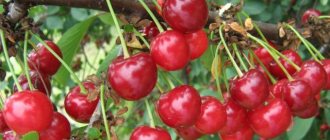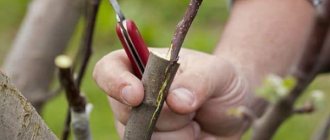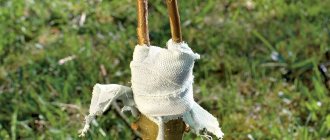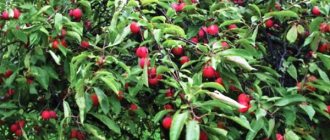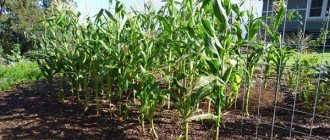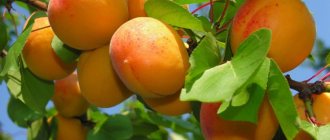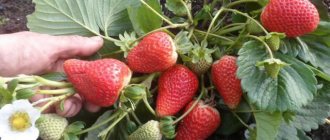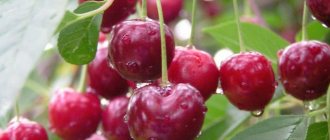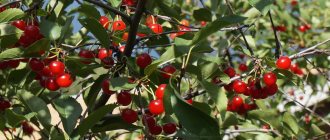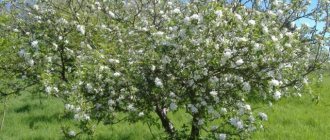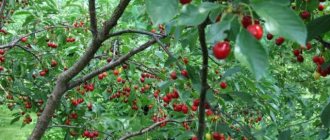When is the best time to plant cherries?
Planting dates may vary depending on the climatic conditions of the growing region and the root system of the plant.
If the seedling has a closed root system (CRS), that is, grown in a container, then it can be planted in spring, summer, and autumn, but no later than a month before frost.
It is recommended to plant young trees with an open root system in the middle zone, northern regions, the Urals and Siberia in the spring, when the snow has melted and the earth has warmed up a little and dried out. This usually occurs in early or mid-April. Planting work must be carried out before the buds swell. If a seedling is purchased in the fall, it must be buried before spring, always before frost sets in. This should be done from mid to late September according to the following scheme:
- Place it in a trench about 0.5 m deep at an angle of 30 degrees, directing the crown to the south.
- Cover the roots and trunk with soil up to the 1st side branch.
- Compact the soil and water it.
- Cover the crown with spruce branches. This way the seedlings will be preserved until spring, when it will need to be planted in a permanent place.
In the southern regions, seedlings with an open root system can be planted in spring or autumn.
Planting in autumn is carried out a month before frost - in the second half of September and throughout October
Pest attacks and control
The most common disease that a gardener growing cherries may encounter is clasterosporiasis. As can be seen in the photo, it appears in the form of light brown spots, which subsequently form small holes on the leaf plate. It can lead to complete loss of the green mass of the tree and even the death of the plant. They fight the disease by spraying with Bordeaux mixture or copper chloroxide. In this case, the damaged areas must be removed.
Cherries are also susceptible to fruit rot or moniliosis. It appears in mid-summer, when the fruits begin to ripen. On each of them affected by the disease, a gradually increasing spot forms. Increased temperature and humidity promote spread. As a preventative measure, you can spray with fungicides.
Cherry trees and insects are very fond of them. The main pests are:
- cherry weevil;
- plum moth;
- leaf aphids;
- cherry sawfly;
- hawthorn caterpillar.
All preventative work to get rid of insects is carried out in early spring. In this way, you can get rid of pests that have spent the winter on the tree and in the soil. To do this, the trunk is treated with copper sulfate.
How to plant cherries in spring: video
Source: sad24.ru
How to choose planting material
Attempts to grow a fruit-bearing cherry tree from a seed or root shoot are likely to end in failure, especially for inexperienced amateur gardeners. The most reliable option is to purchase a grafted seedling from a nursery or garden market. Usually they buy one-year-old or two-year-old trees with mature wood and well-developed roots. You can purchase seedlings with both open and closed root systems.
The range of seedlings is especially wide in the autumn, so it is recommended to buy it during this period. Planting material is selected according to the following external characteristics:
- A healthy young tree has a well-developed root, but few branches.
- The seedling should not have any damage or signs of disease.
- Plant height is approximately 1 m.
- For a two-year-old seedling, the trunk should be about 60 cm in height, the diameter should be at least 2 cm, and the length of the main skeletal branches should be about 60 cm.
In addition to external signs, you need to pay attention to the variety. It is chosen depending on the climatic conditions of the growing region - it must be suitable for them. If the climate is dry, you should choose varieties that tolerate drought well. It is important that cherries are disease resistant.
There is one more selection criterion: some varieties have the appearance of a tree, others have the appearance of a bush.
Rules for caring for garden cherries
Cherry is undemanding to watering. It is necessary to add water under the tree during flowering and fruiting. This will allow the tree to saturate the ripening fruits with moisture. When watering, the soil must be moistened to a depth of 40 cm. The plant must be given water in the period after harvesting. Late watering is carried out until mid-October. This is the last watering in the ending season. In this case, 5-7 buckets of water must be added to each plant.
Due to the rapid growth of shoots on the tree, cherry trees require constant pruning. A thickened tree stops bearing fruit; if there is a harvest, it is meager, and the fruits become small and sour. It is necessary to prune cherries in early spring, 15-20 days before buds appear.
The crown of the cherry tree is formed according to a sparse-tiered pattern. They begin to correct it immediately after planting the seedling. There should be no branches or shoots on the trunk at a distance of 40 cm from the ground. Above, 6-7 main skeletal branches form:
- 1st tier (lower) – 3 branches;
- 2nd tier – 2 branches;
- 3rd tier (top) – 1 branch.
The growth guide is removed above the top tier. As the tree develops, 3 more skeletal branches are added. An adult cherry has about 10 pieces. All interfering shoots are mercilessly removed:
- dry branches;
- small shoots;
- branches growing deep into the crown;
- stepchildren with signs of the disease.
Selecting a location
For cherries, you need to choose an area with good lighting, ventilated, but at the same time protected from strong and cold winds.
Important! It is strictly not recommended to plant cherries in the shade.
It is advisable to plant it on the south or west side. A good location is near a fence or wall of a house where there are no drafts. In addition, snow accumulates in such areas in winter, which protects the root system from frost. The distance to the wall, according to the standards, should be 1.5 m, to the fence - 2 m, in extreme cases - 1 m, no less.
Cherry varieties (variety description and features)
Breeders have developed many varieties of cherries, so choosing a suitable tree is not difficult. Low-growing and large-fruited species are considered especially popular. They are great for growing in small spaces, are disease resistant and produce a rich harvest.
We will look at several popular selectively bred varieties and describe the main features of their planting, cultivation and care.
Felt cherry: cultivation and care
Found in the wild in China and other Asian countries. The value of the variety lies not only in the healthy and tasty fruits, but also in the decorative properties of the tree itself. A low and compact crop can be used to create hedges and decorate a site (Figure 4).
Note: The only drawback of the variety is short fruiting. The tree bears fruit for no more than 10 years, but if rejuvenating pruning is carried out correctly, the period can be increased to 20 years.
Growing and caring for felt cherries primarily involves choosing the right site. It is better to choose light and fertile soil, since soil that is too wet has a negative effect on crop growth. In addition, it does not tolerate shade well, so it must be planted in well-lit areas.
During the growing process, trees are periodically fertilized. To do this, organic and mineral fertilizers are applied to the tree trunk circles immediately after flowering.
Figure 4. Felt cherry fruits
To maintain abundant fruiting, you need to thin out the crown annually. To enhance growth, rejuvenating pruning is also carried out, and in the spring the bushes are inspected in order to remove frozen branches in time.
The fruits of this variety are practically not found on sale, since they are very juicy and do not tolerate transportation well. If you want to transport the crop, the berries are harvested slightly unripe.
Bessey cherry: planting and care, reviews
Planting and caring for this variety differs from other types of this fruit crop. This is primarily explained by the fact that it is not a tree, but a low shrub native to North America (Figure 5).
Planting is carried out on light soils with drainage, since stagnation of moisture can cause rotting of the roots.
Note: The popularity of the variety is explained by the fact that even young seedlings can withstand severe frosts (down to -50 degrees), and fruiting begins in the second year after planting.
Figure 5. External features of Bessey cherry
During the growing process, potassium fertilizers are applied under the tree, which increases the number of fruits. Ripe fruits are dark burgundy, almost black. Their number can be so large that supports are placed around the bush. This gives the branches the support they need and prevents them from falling to the ground and breaking.
Bush cherries: planting and care
Bush cherry is also called steppe cherry. This is a low shrub with numerous lateral shoots, which provide gradual renewal of the crop (Figure 6).
Note: The crop is advantageous in that it tolerates severe frosts and lack of moisture well, and is therefore suitable for cultivation in almost all climatic zones.
The planting area should be sunny, as the crop does not tolerate shade. Since the crop tolerates drought well, watering may not be necessary. But some care for the bush will still be required:
- It is recommended to regularly loosen the tree trunk circles to supply oxygen to the roots;
- Since the plant is not tall, all weeds that can deprive the crop of nutrients should be removed;
- Mineral fertilizing and fertilizers are applied several times a season to ensure a high yield.
Figure 6. Appearance of bush cherries
In addition, bush varieties need to be regularly sprayed against diseases and pests, since they can be damaged by them at all stages of growth.
Neighborhood
According to experienced gardeners, the best neighbors of cherries are honeysuckle, plum and sweet cherry.
It is not advisable to plant it next to pear trees, apple trees, gooseberries, blackberries, raspberries, and currants. The distance to them should be at least 10 m. Raspberries and cherries have common diseases. Pear and apple trees take away nutrients. Gooseberries harm the roots. Currants grow on other soils that are not suitable for cherries.
Bad neighbors include nightshades - eggplants, tomatoes, peppers.
Non-fruit trees not suitable for cherries: birch, poplar, linden, oak, pine, spruce. The distance from them should be at least 10-15 m.
Is it necessary to mulch the soil around the tree?
Mulch helps retain moisture and prevents the soil from forming crust. Therefore, mulched trees need less frequent watering and can better withstand hot, dry weather. In addition, fewer weeds will grow under a thick layer of mulch, making it much easier to maintain the soil under the trees.
The cherry tree trunk is usually mulched with humus, compost, grass clippings, hay, chopped bark or other organic materials. Moreover, the mulch is laid out in a layer of 8-10 cm, retreating from the trunk at least 10 cm.
Autumn mulching will protect the roots of cherries from freezing, because... Under a layer of mulch, the soil does not freeze as much.
Video: At what distance to plant fruit trees from each other
Video: Valery Panov: At what distance should trees be planted?
Soil requirements
Sandy loam, loamy, sandy soils are suitable for cherries.
| Soil type | Characteristic |
| Sandy loam | It consists predominantly of sand with the inclusion of clay particles. It has a light brown color. Lumps form well. Requires sowing of green manure, application of organic fertilizers, and mulching. |
| Loamy | 1/3 consists of clay, the rest is sand and other impurities. The color can be yellow, gray, red-brown. Plasticity is high. Requires the addition of organic matter, sowing of green manure, and mulching. |
| Sandy | Predominance of sand in the composition. It allows water to pass through well, is free-flowing and loose. Requires regular addition of humus or compost. |
Cherries prefer light and fertile soils. Before planting, it is recommended to check the acidity of the soil - it should be neutral. A high level of acidity is indicated by such signs as a light coating on the surface of the earth, horsetail and moss, and rusty water in pits. In this case, deoxidation is necessary, which is carried out using slaked lime, dolomite flour or ash.
Groundwater should not come close to the surface - at least 1.5 m. Otherwise, you will first need to make an embankment of earth 80 cm high, then plant a seedling on it.
Important! Wetlands should not be allocated for planting cherries.
How to prepare cherries for winter?
Cherries tolerate snowy and frosty winters relatively well. But frequent alternations of frost and thaw can destroy not only young, but also adult fruit-bearing plants. To avoid sad consequences due to temperature fluctuations, preparation of trees for the cold season begins in September.
First of all, it is necessary to apply phosphorus and potassium fertilizers so that the tree can properly prepare for winter and does not experience nutritional deficiency during the spring awakening. For this purpose, you can use ready-made mineral complexes, for example, Universal. If you prefer single preparations, add 20-30 g of potassium chloride and 30-45 g of superphosphate to the tree trunk circles, then water the trees thoroughly. On acidic soils, phosphorus-potassium fertilizers can be easily replaced with ash.
Once every few years, it is recommended to use organic fertilizers (for example, compost or rotted manure at the rate of 4-5 kg per 1 sq.m of tree trunk circle). It is important to fertilize no later than September, because... this procedure stimulates the movement of juice. And if you don't hurry, the tree may freeze in winter. Then you should dig the ground to a depth of no more than 7-8 cm, while simultaneously choosing weeds. After which it is advisable to mulch the tree trunk circles. A layer of mulch will prevent the formation of a hard crust and retain life-giving moisture. It is better to cover trees for the winter no earlier than the end of October. But, of course, first of all you should focus on weather conditions, taking into account the characteristics of your climate zone.
Care for cherry trees properly. And then your pies and compotes will not be left without aromatic ripe berries.
Stages of autumn planting
Autumn planting of seedlings with an open root system consists of inspecting and preparing the plant, preparing a hole, and planting itself.
Seedling preparation
First, you need to remove all the leaves to reduce the plant's moisture consumption. Then you need to inspect the roots and remove the rotten ones. If they have dried out, it is tedious to put the young tree in water for three hours. Next, you need to prepare a mash of water, manure and clay, taken in equal quantities.
Pit preparation
The planting hole must be prepared at least 2 weeks before planting.
The process consists of the following steps:
How to grow felt cherries from pits
- Dig a hole. Its width and depth may vary depending on the quality of the soil and the size of the root system. For chernozem - 60X60 cm, about 50 cm deep. For infertile soil, the size needs to be increased to 80 cm wide and 60 cm deep, so that there is room to add fertile soil.
- When digging a hole, throw the top fertile layer and the bottom infertile layer in different directions. The latter will not be needed in the future.
- Mix the soil of the top layer with humus (1 to 1) and add ½ part of wood ash. Mix well and put into the pit. Form a mound out of it.
- Add potassium-phosphorus fertilizers or ash. It is important that when planting, the roots of the cherry trees do not come into contact with them to avoid burns.
Planting process:
- Drive a peg into the middle of the mound to serve as a support.
- Place the seedling next to the peg on the north side. First, they try it on so that the root collar (the place where the roots enter the trunk) does not end up underground. If it turns out to be below ground level, you need to add more soil and try it on again. Make sure it is at ground level.
- Straighten the roots so that they do not bend and hang over the mound.
- Sprinkle the root with fertile soil.
- Water, using half the bucket per hole.
- Cover it completely with fertile soil, without deepening it, so that the root collar is at ground level, otherwise the plant will sprout root shoots.
- Compact the soil.
- Tie the seedling to the support using a knitted cord.
- Mulch the tree trunk circle with rotted manure or peat.
- Water again. There is no need to water frequently in the future. Cherry is unpretentious and drought-resistant.
If you need to plant more than one tree, then the distance between them should be at least 3 meters. If a whole garden is planted, then the distance between the rows is 3.5 m.
In the winter, you need to add a layer of soil about 30 cm thick to the young cherries. In the spring, it needs to be removed.
Methods for planting cherry seedlings with an open root system in the fall
At what distance should cherry trees be planted?
Bush varieties of cherries are planted at a distance of 2-2.5 m from each other. Tree-like forms require more space. They should be placed approximately 3-3.5 m from each other, as well as from other trees and shrubs.
An ideal area for planting fruit and berry trees should be spacious enough and not built up around the perimeter to ensure so-called air drainage, i.e. outflow of cold air. Before planting your own garden, you should evaluate the characteristics of the soil, the illumination of the site, and only then select suitable tree varieties. Cherries take root well on plains and do well on southern and southwestern gentle slopes. They love neutral, moderately sandy soils and loams, but are not particularly fond of peat-bog lands, as well as areas that are flooded during high water.
Before planting, the soil from the dug hole is mixed with humus and mineral fertilizers. Up to 20 kg of humus, about 70 g of potassium and no more than 300 g of phosphate fertilizers can be added to one planting hole. It is also recommended to add up to 1 kg of ash. If the soil is heavy clay, then you can add 1.5 buckets of sand. After planting, it is advisable to form a cushion around the tree trunk to prevent water from spreading during watering. On average, immediately after planting, one young plant requires 20-30 liters of water.
Advantages and disadvantages of autumn planting
Planting cherries in the fall has the following advantages:
- Planting material is of higher quality than in spring. Seedlings are dug up in the fall, and unsold ones are stored until spring. Even with proper storage, they are inferior in viability to autumn ones, since they experienced stress at this time.
- When planted in autumn, the roots develop quickly in the spring and the cherry tree grows well.
- Less exposure to adverse weather factors if planting is done correctly.
- Plants planted in autumn are about 3 weeks ahead of spring plants in development.
- The planting process is simpler and subsequent maintenance is minimal. In the fall, you only need to plant and cover, while in the spring, regular watering, weeding, fertilizing, and fungicide treatment are required.
- All injuries received during the rest period, which lasts throughout the winter, will heal well.
- It is easier to determine the condition of a seedling by its fresh root system.
Choosing a healthy and strong seedling
The seedling must be maximally adapted to the climate of the territory in which it will grow, so the choice of variety should be taken responsibly.
Sometimes, in order to save money, novice gardeners try to grow a seedling from a seed, but obtaining the same fruits as the parent form is unlikely. And if we talk about grafted representatives, then their growth is completely sterile. Therefore, it is better to buy a seedling in well-established stores and nurseries.
When purchasing planting material, you need to carefully inspect it. It should have a developed root system, 3-4 skeletal branches, without swelling, plaque and various damage to the bark.
Planting cherries with a closed root system
A seedling with a lump of earth can be planted in the summer. The soil requirements are the same as for a bare-root plant.
The best time for planting is warm, humid weather.
Planting process:
- Dig a hole the size of a clod of earth. The graft should be above the soil.
- Carefully remove the film from the ball.
- Gently loosen the earthen lump using a knife, making vertical movements. Proceed carefully so as not to damage the root system. Once the roots are free, they will take root better.
- Place the young tree in the hole so that the most developed branches of the seedling are located on the north side.
- Cover with soil and press down firmly with a shovel.
- Pour water (half a bucket per hole).
- Add soil and tamp down with your foot.
- Mulch with quail manure, leaving about 8 cm from the trunk.
Growing cherries from pits at home
Growing cherries from pits is quite difficult. First of all, you need to select suitable seeds, rinse thoroughly with water and dry. After this, they are placed in water for a week, periodically changing the liquid (Figure 8).
Figure 8. The procedure for planting and growing a seedling from a seed
To obtain a seedling, the seeds are placed in a pot with soil and sand, covered and allowed to germinate for two months. With proper care and regular watering, a shoot will appear during this time and can be transplanted into open ground.
It is advisable to carry out the transplant in October. The seedling is planted in a shallow hole (only 3 cm), covered with a layer of mulch and left for the winter. It is worth considering that growing in this way will take quite a long time.
Adviсe
Tip 1
When planting a seedling with a ZKS, there is no need to place a support in the form of a peg, since such trees are already strong.
Tip 2
If you have a choice, it is better to buy seedlings with a clod of earth - in this case, the roots are less damaged and the tree takes root better, and they are also easier to transport and store. The disadvantage is that it is impossible to assess the condition of the roots. In addition, plants with ZCL develop more slowly.
Tip 3
In winters with little snow, you should shovel snow onto the buried seedlings, making a small snowdrift. This way young trees can survive the cold.
Cherry: planting and care in open ground
Caring for cherries requires a lot of work and attention. After fruiting begins, pruning is necessary. Its basic rule is that the tree bears fruit almost entirely on the growth of the previous year. Thus, the main task of pruning a fruit-bearing tree is to create the maximum number of young and strong branches capable of producing a harvest (Figure 9):
- In spring, old fruiting branches are removed to make room for replacement shoots.
- At the beginning of summer, new branches are thinned out on the skeletal branches. There should be a gap of 10-15 centimeters between them.
- On each fruiting branch, leave one young shoot located close to the trunk. There is no need to remove their growing points, and it is better to tie the shoot itself to a supporting wire.
Figure 9. Procedure for pruning an adult tree
Pruning a seedling directly depends on the type of crown being formed. For example, when creating a fan in the first three years after planting, all lateral conductors are greatly shortened to stimulate the growth of lateral shoots. The procedure is repeated until the required number of branches is formed on the tree (Figure 10).
Figure 10. Procedure for trimming a fan crown
There are slow-growing varieties that produce few young shoots. In this case, the central part of the fan stops bearing fruit, and the crop can only be harvested along the periphery of the tree. To correct the situation, in early spring, approximately half of the three- and four-year-old branches are cut off, removing them down to the part with the young shoots that have formed. This will help stimulate new growth.
To form low-standard forms and a pyramidal crown, follow these recommendations (Figure 11):
- In the first year after planting, shorten the central conductor, leaving about a meter of trunk. The side branches are also shortened. This helps stimulate the growth of the central conductor.
- In the second year, new growth of lateral branches, extending from the trunk at a wide angle, is shortened. All other shoots are removed with the exception of branches left in the first year to thicken the conductor. In summer, root shoots and young branches formed below the crown are removed.
- In the third year, the procedure is repeated, stimulating the development of second-order branches, which will fill the free space of the crown.
Figure 11. Formation of a low-standard (a) and pyramidal crown (b)
In the future, the main purpose of pruning is the same as for a fan: old branches are removed annually to stimulate the growth of new fruit-bearing shoots. Dry, diseased and broken parts are also cut out. All cuts must be covered with garden varnish so that the wood does not become a site for the development of diseases. The author of the video, a gardening expert, will tell you how to prune crops correctly.
In the first five years, before fruiting begins, the soil around the seedling must be cleared of weeds. In the future, if the tree develops normally, you can sod the ground by sowing grass, leaving the soil around the trunk free.
The crop is additionally fed by applying mineral fertilizers over the entire root area. Young trees are mulched, covering the soil with a layer of rotted manure or other organic fertilizers with a layer of up to 8 centimeters.
If a tree grows near a wall, in dry weather it needs to be watered abundantly (2.5 liters of water per square meter of land). If drought occurs during the fruiting period, intensive watering cannot be started immediately, as this can lead to cracking of the fruit.
Since flowering occurs in early spring, the tree must be protected from frost by covering it with burlap or netting. Attention should also be paid to the control of diseases and pests. The biggest danger is aphids, but sometimes the tree is also affected by caterpillars of leaf-eating insects. To eliminate aphids, spray with karbofos. Chlorophos, which is also sprayed on the crop except during the flowering period, will help cope with the caterpillars. Figure 12 shows examples of damage to trees by diseases and pests.
The crop is also affected by bacterial canker and milky sheen, and brown rot may appear on the fruits. To eliminate cancer, spray with Bordeaux mixture after harvesting the fruits. Fruits affected by brown rot are collected and burned. Unfortunately, there is no means yet to combat milky shine, so the affected parts of the branches are removed and burned.
Figure 12. Common diseases and pests: 1 - aphids, 2 - brown rot, 3 - bacterial cancer on fruits
If the tree has been properly cared for, the harvest will be very bountiful. As a rule, the berries are left on the tree until fully ripe. The only exception can be fruits that have begun to crack. They must be carefully removed so that the fruits do not become a source of disease.
The fruits are removed from the tree along with the stalk, using pruners or scissors. The berries are not intended to be stored fresh, so immediately after harvesting the fruits must be eaten, frozen or canned.
FAQ
What varieties of cherries should I buy for cold climates? It is better to choose frost-resistant ones, such as Shokoladnitsa, Resistant, Nezyabkaya. The following varieties have been bred specifically for Siberia: Metelitsa, Altaiskaya rannyaya, Shadrinskaya, Altaiskaya krupnyaya, Maksimovskaya, Altaiskaya lastochka.
Is it possible to plant cherries in June? Planting cherries in summer is possible, but only seedlings with a closed system that grow in plastic containers are suitable for this.
How to replant cherry trees from old ones? Shoots are planted only from ungrafted (own-rooted) plants. You need to separate the cuttings from the mother bush in the spring. You should select a specimen located at a distance of 15-20 cm from the mother cherry and cut the root on both sides. Do not dig up cuttings. It needs to be left in place so that over the summer it develops a root system and begins to develop on its own. Then loosen the ground around it, drive a peg nearby and tie it up. During the summer, watering and fertilizing are required. With good care, after a year it can be transplanted to a permanent place.
Why mulch the root circle? Mulch retains moisture, prevents crust from forming on the ground, prevents the germination of weeds, facilitates care, and protects young seedlings from freezing in winter. Mulched plants tolerate heat and drought better and do not require frequent watering.
Where to plant cherries
Typically, this crop grows for 15-20 years, during which time it bears fruit. Therefore, the first thing you need to think about is that you plant the plant not for one year, but for at least 10 years. Therefore, when choosing a place, pay special attention to the surrounding environment. If you plant a small tree near a building or other trees, then after a few years you may encounter a problem; there will be so little space for the plants to develop that you will have to either replant the seedling or move the building or fence aside. Remember that cherries do not like replanting, so plants often die because of this. Cherries grow well in sunny areas protected from the wind. It is better to plant the cherry tree near the fence, but it should not be placed very close. Maintain your distance; the root system of cherries often takes up a lot of surrounding space, so retreat at least 3 meters from buildings or neighboring trees. If you place your plantings near a fence, then in addition to protection from the wind, the fence will protect the roots from frost, since it is in such places that a lot of snow accumulates, the plants winter better in these conditions.
The soil for planting cherries should be light, well-drained and breathable. If we talk about acidity, it is better to choose neutral soil; if necessary, you can add wood ash to the soil. Cherries do not grow well on heavy, marshy soils, so this crop should not be planted in such places. The site should be prepared in the fall; it is advisable to add mineral or organic fertilizer to the soil; if you want to enrich the soil with organic matter, you should add manure to the soil, but you don’t need to add very much of it to the soil. If we talk about potassium and phosphorus fertilizers, then they are used no more than 100 grams per square meter; nitrogen fertilizer is not applied to the soil in the spring, since they oxidize the soil quite strongly and also burn the roots of plants. Be sure to follow the dosage, do not overdo it with organic matter.
In order to grow a good tree, you need to choose the right seedling. Purchase planting material from trusted manufacturers, pay attention to the appearance of the plant, as well as the root system of the seedling. If you live in a region with a harsh climate, then choose frost-resistant varieties, for example, Shokoladnitsa cherries. If frosts are not so active in your region, then you can plant Vladimir, Zhukovskaya or Crimson cherries on your site. In the Urals, the Mayak, Plamennaya or Bolotovskaya varieties are often grown. In fact, there are currently many varieties of this crop, so you can always choose what is right for you, so periodically get acquainted with new breeding achievements; every year the varietal characteristics of cherries become better and better. Very often, beginning gardeners plant cherries from root shoots or pits. Don't forget that free cheese only comes in a mousetrap, so the quality of the new plant may differ significantly from its parent forms. Grafted cherries that shed shoots also cannot be propagated using the methods presented, since such plants usually turn out to be sterile. It is best to purchase an inexpensive seedling from a specialized nursery or garden center. Freshly purchased seedlings should be planted immediately, but cherries can be purchased in the fall and planted in the spring. But in this case, you will need to take care of wintering the plant, and it is not a fact that everything will work out for you, so it is best to buy a seedling and plant it in open ground at the same time of year. This way the plant will remain fresher and healthier.
The seedling can be stored for some time as follows: dig a small hole in the area, place the seedling there in a horizontal position, dig in the roots. It is advisable to direct the rhizome of the seedling to the south. This way you can protect the seedling from adverse environmental influences for some time. In order for the plant to overwinter normally, pine and spruce branches are often placed on top of the hole. Such a pile protects the seedling from frost, but rodents will definitely not grow in such a litter. Do not forget that seedlings cannot be stored in a humid environment, so do not dig them in where melt water usually accumulates. Choose an elevated place for this, where the snow will lie longer. Remember that this is still a temporary shelter, and in early spring you will have to send the seedling to a new habitat. When you purchase a plant from a nursery, inspect it carefully. It should be about one meter in height, the trunk and root system must be well developed. Each seedling should have three or four skeletal branches with a length of up to 60 cm. In addition, the plant should not have any damage, defects or growths. The bark should be fresh, not swollen.
Pruning cherry seedlings
In the spring, when the buds have not yet blossomed, the plants are pruned. First of all, broken and diseased shoots are removed. When the crown thickens, it is discharged. Cover very large cuts with varnish and oil paint. Otherwise, this may lead to drying out and death of the plant. During the first five years, the tree grows rapidly. In this regard, thin out the crown annually.
All shoots located below 60-80 cm are removed from a one-year-old seedling. This is how we will form a trunk. Above we leave 4-5 well-developed branches, which will later become skeletal. In the second year, step back 80 cm from the upper skeletal branch and cut off the central conductor. This will ensure that the tree stops growing in height, which is more convenient when harvesting.
Be sure to remove root growth. It is often a breeding ground for pests and impairs the nutrition of the main tree. It must be removed along with the roots. If the shoots are simply mowed or cut at soil level, then they only become denser.
Cherries bear fruit well for 10-15 years. Then it is better to replace it with new plants.
As you can see, growing and caring for cherries is not particularly difficult. A little effort, and the tree will delight you with its harvests for many years.
Agricultural technology of Ovstuzhenka cherries
When caring for a cherry orchard, it is necessary to clear the tree trunk of weeds, loosen it, water the tree as needed and shape the crown.
Watering
Cherries do not tolerate stagnation of water. During prolonged rains there is a risk of fungal diseases. Adult plants are watered three times a season, 3 buckets per tree. Watering is especially important during fruit formation. Trees planted in spring are watered at first every 5 days (1 bucket). In autumn, 1-2 waterings are enough. Then, in the year of planting, young seedlings are moistened once a month (1 bucket) in hot weather
It is important to stop watering after the fruits ripen so as not to stimulate the rapid growth of new shoots, which significantly reduces the winter hardiness of cherries. In October, pre-winter watering is carried out in dry weather - 60–70 liters of water are poured into the irrigation grooves (per tree). Water is added to the irrigation ditch three times per season.
Water is added to the irrigation ditch three times per season.
Top dressing
In the first year, cherries are not fertilized; they have enough nutrients added to the soil during planting. The next year, in early spring, add dry urea (100 g) or a solution (30 g\10 l). In autumn, saltpeter (400 g) is scattered under the tree and covered with earth. It is very useful to fertilize with mullein solution once every 2 years. For young trees, 10 kg of manure will be enough, for adults - 25 kg. After 5–6 years, slaked lime is added to the soil.
After fruiting begins, the amount of fertilizer is increased by 30%. In spring, urea (300 g) is added, in autumn potassium salt (200 g) and superphosphate (400 g).
Cherries should not be overfed with fertilizers; the norm should be observed.
Crown formation
Proper crown formation is of great importance when growing cherries. The central conductor of the planted tree is immediately cut off.
In the second year, before the start of sap flow, 3 branches are left on the bottom row, one of which should be 20 cm higher than the others. They are shortened by a third. The central shoot is cut at a height of 1 m from the first row.
In the third year, 3 shoots are left on the second tier, the remaining branches are cut out. The central shoot is shortened again at a height of 1 m from the branches of the second row. A year later, the last tier of 3 branches is formed.
To form a spreading and well-lit crown, it is thinned out and branches growing inwards are cut out. In autumn, remove dry and diseased branches. After pruning, all sections are disinfected with varnish.
The formation of the crown and skeletal branches is carried out over 4 years according to the following scheme:
Crown formation takes place over 4 years
The sharp angle of the branches is dangerous; a break may occur here. Using ordinary wire, the branch is fixed by increasing this angle. A young tree's branches are flexible and will take the given direction of growth.
Preparing for winter
In the fall, the circle around the trunk is loosened, mulched with straw and sawdust with a layer of 5 cm. To protect the bark from burns, the trunk must be whitened, first clearing the bark of dry crusts and moss. You can prepare whitewash yourself from 500 g of copper sulfate, 2 kg of chalk and 100 g of glue.
Ovstuzhenka cherry can withstand frosts down to -27C. However, young plants may suffer during early autumn frosts. Sharp temperature fluctuations, when frosts give way to thaws, are also dangerous for the tree; flower buds are often damaged. Therefore, in the first 3 years, it is advisable to cover the trees with non-woven material that allows air and moisture to pass through. It wouldn’t hurt to cover the trunk with spruce branches to prevent rodent attacks.

